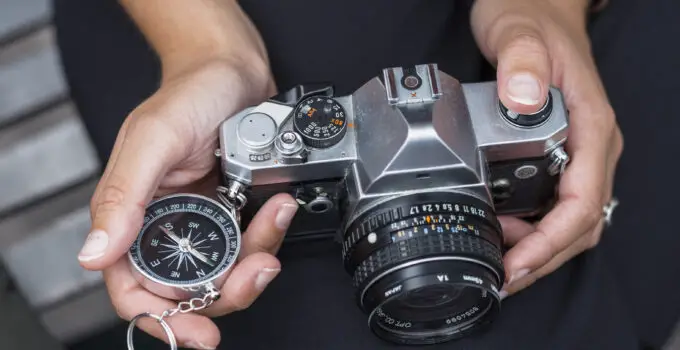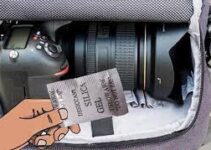Ever wondered how to maintain the pristine condition of your beloved analog camera?
Cleaning the inside of an analog camera is crucial for ensuring clear, high-quality photographs and prolonging the lifespan of your equipment.
Dust, debris, and moisture can accumulate over time, affecting image quality and functionality. By following proper cleaning techniques, you can preserve the precision of the camera’s mechanisms and optics.
In this guide, we explore step-by-step methods to safely clean the inside of an analog camera, providing you with the knowledge to keep your equipment in optimal condition for years to come.
Here, how to clean under water camera housing?
What is analog camera?
An analog camera is a type of camera that captures and records images using film or another analog medium.
Unlike digital cameras, which use electronic sensors to capture images, analog cameras rely on a chemical process.

Light enters the camera through a lens, strikes the film, and triggers a chemical reaction that creates a latent image.
This image is later developed in a darkroom using various chemicals to produce a visible photograph.
Analog cameras can range from simple point-and-shoot models to sophisticated single-lens reflex (SLR) cameras, offering a variety of manual controls over exposure, focus, and other settings.
While digital cameras have largely overtaken the market due to their convenience and advanced features, analog cameras are still appreciated by enthusiasts for their unique aesthetic qualities, tangible nature, and the depth of skill required in both shooting and developing photographs.
Is it important to clean analog camera?
Yes, it is important to clean an analog camera to ensure its longevity and maintain the quality of the photographs.
Dust, dirt, and debris can accumulate on the lens, film compartment, and other components, which can degrade image quality and potentially damage the camera.
Regular cleaning of the lens is crucial to avoid scratches and ensure clear, sharp images. The film compartment and rollers should also be kept clean to prevent scratches or marks on the film.
Additionally, cleaning the viewfinder and focusing screen helps maintain clear visibility when composing shots.
Proper cleaning involves using appropriate tools such as a blower, soft brush, microfiber cloth, and lens cleaning solution.
Here, how to clean lifeproof case camera lens?
Regular maintenance not only preserves the functionality of the camera but also enhances the overall photographic experience by ensuring that the camera performs optimally.
When to clean analog camera?
Things to know before cleaning analog camera?
Camera cleaning tips?
How to clean the inside of an analog camera?
9 Steps to clean analog camera
1. Gather Cleaning Supplies
Before starting, collect all necessary cleaning supplies to ensure you have everything on hand.
Essential items include a blower, soft brush, microfiber cloths, lens cleaning solution, cotton swabs, isopropyl alcohol (90% or higher), and lens tissue paper.
These tools help you clean various parts of the camera without causing damage. Avoid household cleaners and rough cloths, which can harm delicate surfaces.
Here, how to clean an old camera case?
2. Remove Film and Batteries
Begin by removing the film and batteries from the camera. This step prevents accidental exposure of the film and protects the camera’s electrical components.
Open the film compartment and gently take out the film, then remove the batteries to ensure safety during the cleaning process.
3. Use a Blower
Use a blower to remove loose dust and debris from the camera’s exterior and interior.
Hold the camera upside down and use the blower to dislodge particles from the lens, viewfinder, film compartment, and other crevices. This step helps prevent scratches and ensures a clean working surface for further cleaning.
4. Clean the Lens
Apply a small amount of lens cleaning solution to a microfiber cloth, not directly to the lens. Gently wipe the lens in a circular motion, starting from the center and moving outward.
Use a blower and a soft brush to remove any remaining particles. Avoid excessive pressure, which can scratch the lens.
5. Clean the Viewfinder
Clean the viewfinder with a microfiber cloth or lens tissue paper.
If needed, lightly dampen the cloth with lens cleaning solution. Gently wipe the viewfinder to remove smudges and dust. This step ensures clear visibility when composing shots and enhances the overall photographic experience.
6. Clean the Film Compartment
Use a blower to remove dust and debris from the film compartment. For more thorough cleaning, use a soft brush to dislodge particles from corners and crevices.
Lightly dampen a cotton swab with isopropyl alcohol and clean the rollers and film path. Ensure all components are dry before reloading film.
7. Clean the Mirror and Shutter
If accessible, clean the mirror and shutter with a blower and a soft brush.
Be extremely gentle to avoid damaging these delicate components. Do not touch the mirror or shutter directly with your fingers or cleaning tools, as this can cause scratches or misalignment.
8. Clean the Exterior
Wipe the camera’s exterior with a microfiber cloth to remove fingerprints, dust, and dirt.
For stubborn spots, lightly dampen the cloth with a small amount of isopropyl alcohol. Clean the body, buttons, and dials carefully to maintain the camera’s appearance and functionality.
Here how to clean a camera equipments?
9. Final Inspection and Assembly
After cleaning, inspect the camera thoroughly to ensure all parts are clean and dry. Check for any remaining dust or smudges. Reassemble the camera by reinserting the batteries and loading a new film roll.
Perform a quick test to ensure everything functions correctly. Regular cleaning and maintenance extend the camera’s lifespan and improve photographic results.
5 methods to clean analog camera
1. Blower and Brush Method
The blower and brush method is a fundamental technique for cleaning an analog camera, especially for removing loose dust and debris.
Start by using a blower, a small hand-held device that emits a burst of air to dislodge particles from the camera’s exterior and interior components.
Hold the camera upside down to allow gravity to help remove the dislodged particles.
Use the blower to clean the lens, viewfinder, film compartment, and other crevices where dust may accumulate. Following the blower, use a soft, anti-static brush to gently sweep away any remaining dust.
The brush is particularly useful for reaching corners and intricate parts that the blower might miss.
This method is effective because it prevents direct contact with sensitive components, reducing the risk of scratches or other damage.
Regular use of the blower and brush method helps maintain the camera’s cleanliness without causing harm to its delicate parts.
2. Microfiber Cloth and Lens Cleaning Solution
Using a microfiber cloth and lens cleaning solution is essential for maintaining the clarity and quality of the camera lens. Begin by applying a small amount of lens cleaning solution to a microfiber cloth, never directly to the lens.
Gently wipe the lens in a circular motion, starting from the center and moving outward.
This technique ensures that smudges, fingerprints, and minor debris are effectively removed without scratching the lens surface.
The microfiber cloth is designed to attract dust and absorb oils, making it ideal for this purpose. Additionally, use this method to clean the viewfinder and any other glass components.
For particularly stubborn spots, you might need to apply a bit more pressure, but always be gentle to avoid damage.
Regular cleaning with a microfiber cloth and lens solution ensures that your images remain sharp and clear, enhancing your overall photography experience.
3. Isopropyl Alcohol and Cotton Swabs
Isopropyl alcohol and cotton swabs are excellent for cleaning smaller, intricate parts of an analog camera, such as the film compartment rollers and the film path.
Use isopropyl alcohol with a concentration of 90% or higher to avoid leaving any residue. Lightly dampen a cotton swab with the alcohol and gently clean the rollers and other small components.
This method is particularly effective for removing grime and sticky residues that can accumulate over time. Be cautious not to oversaturate the swab to prevent excess liquid from seeping into the camera’s internal mechanisms. Use a dry cotton swab to wipe away any remaining moisture.
This meticulous cleaning approach ensures that all moving parts function smoothly, preventing film scratches or transport issues.
Regular use of isopropyl alcohol and cotton swabs helps maintain the cleanliness and efficiency of your camera’s internal components.
Here, how do i clean a canvas and leather bag?
4. Sensor Cleaning
For cameras with interchangeable lenses, sensor cleaning is crucial to maintain image quality.
Although the sensor is technically part of a digital camera, analog cameras with certain types of electronic components may require similar attention. Begin by using a blower to remove loose dust from the sensor area.
If dust remains, use a sensor cleaning swab and appropriate cleaning solution designed for camera sensors.
Apply a small amount of solution to the swab and gently wipe the sensor in a single direction.
Follow up with a dry swab to remove any residual moisture. It’s important to be extremely gentle and precise to avoid damaging the sensor.
This method ensures that any dust or particles that could interfere with image capture are removed, resulting in clearer photographs.
Regular sensor cleaning is essential for maintaining the performance and longevity of cameras with electronic components.
5. Professional Cleaning Services
For those who are unsure about cleaning their analog camera or for thorough maintenance, professional cleaning services are a reliable option.
Camera technicians have the expertise and specialized tools to clean both the exterior and interior of your camera, including hard-to-reach areas and delicate components.
They can also perform detailed inspections to identify and address any potential issues that may not be apparent to the average user.
Professional services often include sensor cleaning, lens calibration, and even repairs if necessary.
This method ensures that your camera is in optimal condition, reducing the risk of damage from improper cleaning techniques. While it may involve a cost, professional cleaning can be a worthwhile investment, particularly for high-value or vintage cameras.
Regular professional maintenance complements at-home cleaning efforts, extending the lifespan of your analog camera and ensuring consistently high-quality photographic results.
5 benefits to clean analog camera
1. Enhanced Image Quality
One of the primary benefits of regularly cleaning an analog camera is the significant improvement in image quality.
Dust, dirt, and smudges on the lens or viewfinder can create blurry or distorted images, reducing the sharpness and clarity of your photographs.
By maintaining a clean lens, you ensure that light passes through unobstructed, capturing the true essence of the scene.
Similarly, cleaning the viewfinder allows for a clear line of sight when composing shots, resulting in more accurate framing and focus.
Here, does alaska airline count camera bag as carry on.
This meticulous care helps produce images with vibrant colors and fine details, enhancing the overall aesthetic appeal of your photographs.
Clean equipment ensures that your artistic vision is accurately translated into each shot, providing consistently high-quality results.
2. Extended Camera Lifespan
Regular cleaning and maintenance significantly extend the lifespan of an analog camera.
Dust and dirt can accumulate in the camera’s mechanical components, such as the shutter, mirror, and film transport mechanism, leading to increased wear and tear.
Over time, this can result in malfunctions or the need for costly repairs.
By keeping these components clean, you reduce the friction and stress on moving parts, ensuring smoother operation and preventing premature failure.
Moreover, cleaning the exterior and interior of the camera protects against corrosion and other environmental damage.
Consistent maintenance helps preserve the camera’s structural integrity, allowing you to enjoy its use for many years. This proactive approach not only saves money on repairs but also maintains the camera’s value, making it a worthwhile investment.
3. Improved Performance and Reliability
A well-maintained analog camera performs more reliably and consistently.
Dust and debris in the film compartment or on the rollers can cause scratches or imperfections on the film, leading to disappointing results.
Cleaning these areas ensures that the film advances smoothly and without damage, providing consistent exposures.
Additionally, maintaining clean battery contacts and electrical components ensures reliable power delivery, preventing unexpected failures during shoots.
Regular cleaning also helps identify potential issues early, allowing for timely repairs and preventing breakdowns during critical moments.
This attention to detail enhances your confidence in the camera’s performance, enabling you to focus on your creative process without worrying about technical problems.
A clean, well-maintained camera is more likely to deliver dependable results, making your photographic experience more enjoyable and stress-free.
4. Preservation of Camera Value
For collectors and enthusiasts, preserving the value of an analog camera is essential.
Regular cleaning and maintenance keep the camera in excellent condition, maintaining its aesthetic and functional appeal.
A well-preserved camera, free of scratches, dents, and operational issues, retains its value better over time.
This is particularly important for vintage or high-end models, which can appreciate in value when kept in pristine condition. Proper care, including cleaning, ensures that the camera remains attractive to potential buyers or collectors.
This preservation of value not only provides a sense of pride in ownership but also offers financial benefits should you decide to sell or trade the camera in the future.
Maintaining a clean, well-functioning camera enhances its marketability and ensures that it remains a valuable asset.
5. Enhanced User Experience
A clean analog camera provides a more enjoyable and efficient user experience.
Handling a well-maintained camera is more pleasant, as it feels clean and operates smoothly.
The absence of dirt and grime makes adjusting settings, changing film, and composing shots more comfortable and precise.
A clear viewfinder and spotless lens contribute to a seamless shooting process, allowing you to focus on creativity rather than dealing with distractions caused by dirty equipment.
Additionally, the peace of mind that comes with knowing your camera is in top condition enhances your confidence and enthusiasm for photography.
This improved user experience can inspire more frequent and satisfying photo sessions, helping you develop your skills and passion for the art.
Regular cleaning ensures that your interactions with the camera are always positive, fostering a deeper connection to your photographic endeavors.
How to clean an analogue camera?
To clean an analog camera, follow these steps:
How to clean the inside of your camera?
Can you clean the inside of a film camera?
Yes, you can clean the inside of a film camera, but it requires careful handling to avoid damaging delicate components.
Begin by removing the film and batteries to prevent any accidents or exposure issues. Use a blower to gently remove loose dust and debris from the film compartment, mirror, and shutter mechanism.
A soft, anti-static brush can help dislodge stubborn particles from corners and crevices without scratching surfaces.
For more thorough cleaning, lightly dampen a cotton swab with isopropyl alcohol (90% or higher) and carefully clean the rollers and film path. Avoid excessive moisture to prevent damage to mechanical parts.
It’s crucial to handle the mirror and shutter mechanism with extreme care, using gentle air puffs or soft brushes to remove dust without direct contact.
Regular cleaning helps maintain the camera’s performance and prolong its lifespan, ensuring smooth operation and preventing potential issues like film jams or uneven exposures.
Here, how to clean your dior canvas camera bag?









